[Top] [Prev]
[Next]
"Look Ma, No Wires": Marconi and the Invention of Radio"
Historical Background
James Clerk Maxwell (1831 - 1879)
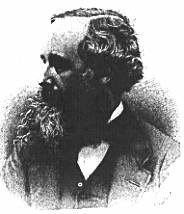 Maxwell's equations described
the fundamental relationship between electricity, magnetism, and wave propagation.
Underlies all radio and cable communications. Light and radio waves are
the same phenomena. Provides the theoretical explanation for why radio waves
can be focused and reflected just like light.
Maxwell's equations described
the fundamental relationship between electricity, magnetism, and wave propagation.
Underlies all radio and cable communications. Light and radio waves are
the same phenomena. Provides the theoretical explanation for why radio waves
can be focused and reflected just like light.
"... we have strong reason to conclude that light
itself -- including radiant heat, and other radiations if any -- is an
electromagnetic disturbance in the form of waves propagated through the
electromagnetic field according to electromagnetic laws." Maxwell,
Dynamical Theory of the Electromagnetic Field, 1864.
The equations state the following: only in a steady state can a magnetic
field exist without causing an electric field and vice versa. When one is
changing, it automatically brings the other into being for as long as the
change continues. These mutually generating fields must be at right angles
to each other, and they must both travel with the same velocity, which is
equal to that of light.
One implication: other forms of electromagnetic waves than light exist,
travel at the same speed as light, but differ from it in terms of frequency
and wavelength. Verified experimentally by Hertz in late 1880s.
1850s: Professor at King's College, London
1871: Chair in Experimental Physics at Cambridge University
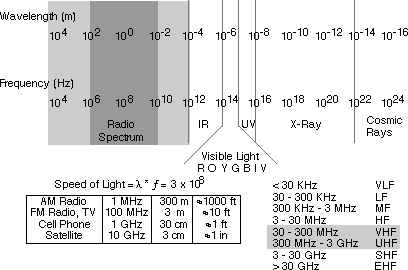
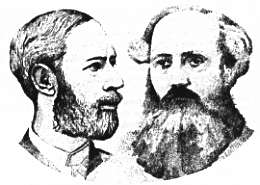 Hertz and Maxwell
Hertz and Maxwell
Heinrich Hertz (1857 - 1894)
Hertz is the unit of frequency: cycles per second.
Demonstrated experimentally the wave character of electrical transmission
in space. Developed apparatus that could transmit high frequency, meter
length waves.
1883: Professor at the University of Kiel
1885: Professor at the Technical University, Karlsruhe
Principle of resonance between transmitting and receiving circuits. Increased
distance over which these waves could be detected by making the transmitter
and receiver identical. Measured the inverse distance relationship (the
strength of the transmitted wave falls off as the inverse of the distance,
as opposed to the inverse squared as shown by Faraday).

Linear Oscillator: two straight metal rods terminated by metal spheres,
storing capacitance. Generates waves that are "linearly polarized."
That is, radiated electric field is parallel to the rods. A detector placed
at right angles would detect nothing.
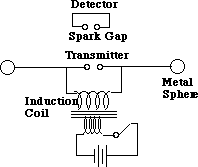
Demonstrated that short wavelength radio waves can be concentrated into
beams by parabolic reflectors. Dimensions of the reflectors on the order
of (or greater than) the wavelength. Concept of gain: transmission
is more effective than possible with simple dipole aerials.
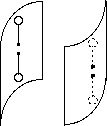
Guglielmo Marconi
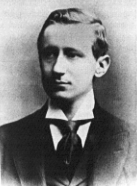 1895:
21 year old Guglielmo Marconi demonstrated that electromagnetic radiation,
created by spark gap, could be detected at a much greater distance than
that considered by Hertz. While these effects were known to experimentalists,
Marconi had made many improvements to the basic antenna, coherer, and tuning
components, and rapidly developed a capability to wirelessly transmit signals
over several miles.
1895:
21 year old Guglielmo Marconi demonstrated that electromagnetic radiation,
created by spark gap, could be detected at a much greater distance than
that considered by Hertz. While these effects were known to experimentalists,
Marconi had made many improvements to the basic antenna, coherer, and tuning
components, and rapidly developed a capability to wirelessly transmit signals
over several miles.
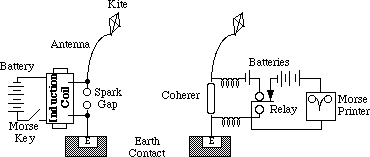
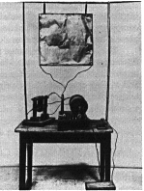 Coherer: vacuum tube
with connections on the ends, filled with iron filings. Electromagnetic
waves force the filings to "cohere", or align themselves between
the connections. Invented by Branly. Tapping with a relay-controlled hammer
causes the coherer to reset itself in preparation for detecting the next
wave train.
Coherer: vacuum tube
with connections on the ends, filled with iron filings. Electromagnetic
waves force the filings to "cohere", or align themselves between
the connections. Invented by Branly. Tapping with a relay-controlled hammer
causes the coherer to reset itself in preparation for detecting the next
wave train.
Marconi's insight: elevated antennas with kites, one metal plate on the
ground. Yielded a much improved distance in transmission and detection.
He first offered his invention to the Italian government, but they rebuffed
him. The son of an Anglo-Irish daughter of the Jameson Whiskey family, Marconi
traveled to England, where he received a warmer reception for his invention.
1897: Demonstrated his wireless telegraphy system on Salisbury
Plain, winning interest of the Royal Navy in communicating with ships at
sea.
1898: Installed radio sets on the Royal
yacht, and was able to report the results of ship regattas to shore.
1899: Marconi demonstrates wireless telegraphy in US. Reported
the international yacht races off Sandy Hook , Long Island.
"The possibilities of wireless radiations are enormous."
Marconi, 1899.
British and Italian navies became Marconi's earliest customers, sustaining
the Marconi Wireless Company during early days. Germans developed a rival
system, unencumbered by Marconi's patents and heavily subsidized by governments
funds. The latter eventually developed into the Telefunken Corporation.
The pre-WWI arms race had come to communications.
 Spark
Gap Transmitter
Spark
Gap Transmitter
Spark gap transmitters transmit across a broad range of frequencies.
Strong nearby transmitter can block out weak signals from far away. Next
innovation is the notion of tuning: use of a resonant circuit to limit the
spread of frequencies radiated by a transmitter and those to which a receiver
would detect. General concept demonstrated by Sir Oliver Lodge in 1889:
adjust receiver coil to same length as transmitter coil to achieve resonance.
Marconi's patent 7777 (April 1900): transmitting aerial coupled to induction
coil, receiving aerial coupled to coherer via a high frequency transformer,
a tapped inductor in series with aerial, and a capacitor (Leyden jar). Vary
the capacitance to "tune" the transmitter and receiver into resonance.
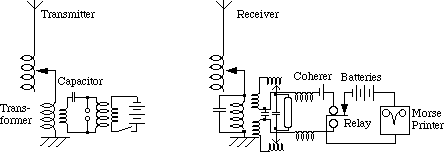
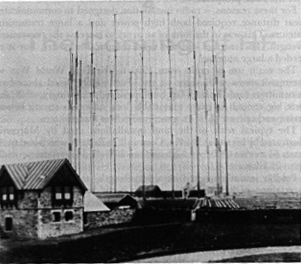 1901: Marconi
succeeded in receiving a long wave (> 1Km) transmission from the coast
of England (Poldhu, Cornwall, 25 kW alternator-based transmitter) to the
coast of Canada (Glace Bay, Newfoundland, antenna: 50 copper wires, 160
ft high, arranged as an inverted triangle). December 12, 1901: the signal
. . . ("S") is heard at Glace Bay sent from England. 700 mile
transmission range during day, improved to 2000 miles at night. Practical
to keep in communications with shipping across the Atlantic.
1901: Marconi
succeeded in receiving a long wave (> 1Km) transmission from the coast
of England (Poldhu, Cornwall, 25 kW alternator-based transmitter) to the
coast of Canada (Glace Bay, Newfoundland, antenna: 50 copper wires, 160
ft high, arranged as an inverted triangle). December 12, 1901: the signal
. . . ("S") is heard at Glace Bay sent from England. 700 mile
transmission range during day, improved to 2000 miles at night. Practical
to keep in communications with shipping across the Atlantic.
Hertzian waves are not like light; they bend around the curvature of
the earth. Explained by the proposed existence of an electrically conducting
layer in the upper atmosphere: ionosphere.
1903: International Conference held at Berlin to settle
allocation of priorities and rights. Maritime safety a high concern. Dictates
the rules of interoperation across different systems and allocates spectrum
among government. military, and commercial uses.

1907: After continuous experimentation and refinement,
using ever more powerful transmitters (over 100 Kws!) and longer wavelengths,
requiring more expensive and extensive antenna farms (30 x 100 m antenna
masts), Marconi achieved regular transatlantic radio cable service. Discovers
that range increases with increasing wavelength (16 KHz, 20,000 meter wavelengths
used to communicate to the antipodes). NOTE: Marconi's system is wireless
telegraph; unable to transmit voice at this point. Spark radiations difficult
to modulate. Sound requires a mechanism for generating continuously oscillating
signals -- the vacuum tube.
Marconi's company set up shore-based radio stations and placed radio
sets on the majority of transatlantic steamers.
1912: a Marconi set was aboard the ocean liner Titantic
when it went down; its existence is credited with averting an even greater
loss of life (David Sarnof, future chairman of RCA, mans the telegraph key
during the disaster). Two ships near the Titantic had shut down their radio
sets at 11 PM -- several hours before the disaster -- and missed the call
for ship in distress (CQD and SOS). Marine radio telegraphy become widespread,
and is monopolized by Marconi.
1914-1918: Wireless plays key role in war. Within hours
of commencement of hostilities, a strategic coup: British Navy cut Germany's
overseas telegraphic cables. German overseas radio stations systematically
attacked and shut down. Germans similarly cut Britain's overland cables
to India passing through Turkey, and severed communications links across
the Baltic to Russia. Marconi hurried to complete several radio stations
under contract from the British government, to reestablish communications
with overseas possessions. The techniques of communications intelligence
(comint) such as message interception, cryptoanalysis, direction finding,
jamming, and intelligence gathering developed rapidly.
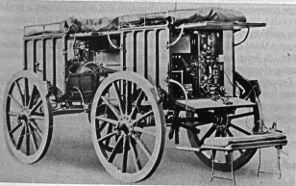 Mobile Radio,
circa WWI
Mobile Radio,
circa WWI
1916: Marconi's focus on longwave, high power transmission
did not yield mobile radio sets. However radios were used on some mobile
equipment and airplanes. Airborne to ground communications (transmit only)
during WWI:
"It became clear as we made our preparations ...
was not going to be anywhere near as simple as it had sounded. The first
problem was the shear weight of the wireless apparatus. The guts of the
system was a marvellously archaic contraption called a spark-generator.
This worked by creating an arch through the teeth of a brass cog-wheel
spinning against an electrode. Every time a tooth passed the electrode
a spark jumped across the gap, and in this way, when connected to the aerial,
it would produce a hideous, rasping crackle -- barbed wire made audible.
The principle of signalling was that the operator worked a Morse key to
turn this excruciating noise into a signal: a crackle for a dash and a
short one for a dot.
"That part of the wireless alone weighed about thirty
kliograms. But there were all the other accoutrements that went with it.
Power was provided by a dynamo fixed on to a bracket under the aeroplane's
nose and driven by a leather belt from a pulley-wheel on the propeller
shaft: that weighed about seven kilograms. Then there was the aerial: twenty
meters of wire with a lead weight at one end to trail behind us in flight,
plus a cable reel to wind it in when not in use: about ten kilograms' worth
in all. Other accessories comprised a signal amplifier, a tuning coil,
an emergency battery, an ammeter, a set of signal rockets plus pistol and
a repair kit. Altogether the wireless apparatus -- weighed about 110 kilograms.
Or to put it another way, the weight of a very fat man as a third crew
member."
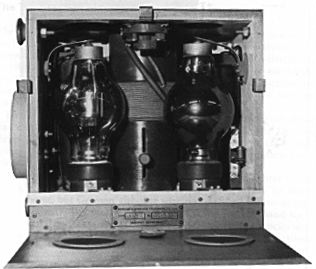 Airborne
Radio Telephone, after WWI
Airborne
Radio Telephone, after WWI
1917: US Navy takes over Marconi's stations for the
remainder of the war. Navy orders 10,000 radio sets for its fleet. Radio
manufacturing scales up. Becomes the domain of large corporations.
1917: The Infamous Zimmermann Telegram
 German Foreign Minister
Arthur Zimmerman
German Foreign Minister
Arthur Zimmerman
Before U. S. entered the war, German Foreign Minister Zimmermann sent
a telegram to the German Ambassador in Washington, via three routes: via
radiotelegram direct to North America, via Sweden, and by the American embassy
in Berlin(!) via the U. S. embassy in Copenhagen and thence to Washington.
The message was in a German diplomatic code. British cryptanalysts had received
copies from all three routes, and had cracked the code in their legendary
Room 40 in the Admiralty. While they knew the provocative contents of the
telegraph, they needed a way to reveal it to the U.S. government without
letting the Germans know that they had the ability to read essentially all
of their diplomatic cable traffic. With the help of an employee in the Mexican
Telegraph Office, a British agent in Mexico had obtained a copy of the telegram
which had been forwarded from Washington to Mexico City, with minor changes
from the original cable. This they handed over to the U.S. Government, and
the Germans believed that they intercept had taken place in North America,
not in Europe. In it, the Germans attempted to
incite the Mexican government to enter the war against the U. S., promising
them Texas, New Mexico, and Arizona as their prize. The telegram's existence
helped to bring the U. S. into the war.
 Zimmermann Telegram
in the German Diplomatic Code
Zimmermann Telegram
in the German Diplomatic Code
1920s: Marconi discovers that short waves, reflected
off of the Ionosphere, offered a much better communications method requiring
substantially lower power, and more compact antenna systems and radio sets.
Initial experiments with 10 kW transmitter power, 100 m wavelength, heard
at 1250 miles during day, 2230 miles at night). Demonstrated that the received
signal strength varied not as the power of the transmitter but rather as
the distance from the transmitter, fading out and reappearing far from the
transmitter site. By 1924, using shortwave techniques, Marconi was able
to send a voice message from England to the Antipodes (aka Australia).
British and U.S. governments did not believe that shortwaves could be
harnessed for effective communications. These "useless" or "junk"
bands given to amateur "ham" radio operators. Further development
of vacuum tubes enables shortwave transmission. Since this time, a continuing
race to be able to harness higher frequencies, shorter wavelengths.
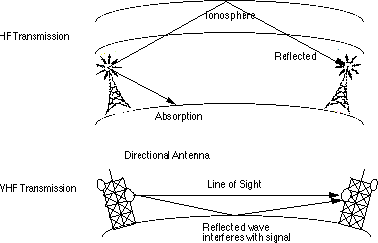
First time in history that something smaller and cheaper actually outperformed
something larger and more expensive. Cable and longwave transmission passed
from the communications scene. By World War II, shortwave radio had developed
to the point where small radio sets could be installed in trucks or jeeps,
or carried by a single soldier. Two-way mobile communications on a large
scale, revolutionized mobile/combined arms warfare over wide areas.
Shortwave services subject to interruption during ionospheric storms.
Gradually replaced by submarine telephone circuits and satellite services.
Still used for world-service broadcasting, maritime and defense services.
[Top] [Prev]
[Next]
Last Updated 22 February 1997, Randy H. Katz, randy@cs.Berkeley.edu
 Maxwell's equations described
the fundamental relationship between electricity, magnetism, and wave propagation.
Underlies all radio and cable communications. Light and radio waves are
the same phenomena. Provides the theoretical explanation for why radio waves
can be focused and reflected just like light.
Maxwell's equations described
the fundamental relationship between electricity, magnetism, and wave propagation.
Underlies all radio and cable communications. Light and radio waves are
the same phenomena. Provides the theoretical explanation for why radio waves
can be focused and reflected just like light.
 Hertz and Maxwell
Hertz and Maxwell









 Mobile Radio,
circa WWI
Mobile Radio,
circa WWI
 German Foreign Minister
Arthur Zimmerman
German Foreign Minister
Arthur Zimmerman Zimmermann Telegram
in the German Diplomatic Code
Zimmermann Telegram
in the German Diplomatic Code